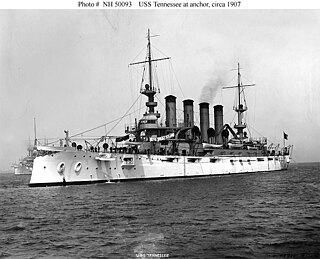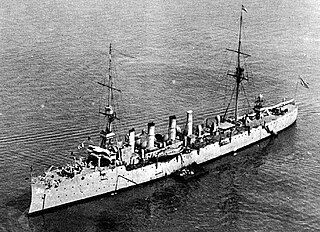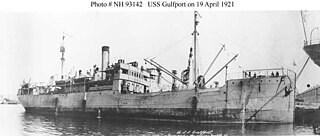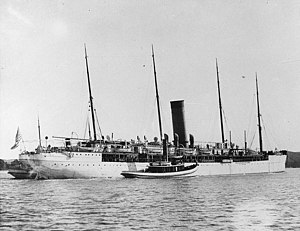
The second USS Tennessee (ACR-10), also referred to as "Armored Cruiser No. 10", and later renamed Memphis, was a United States Navy armored cruiser, the lead ship of her class.

The seventh USS Washington (ACR-11/CA-11/IX-39), also referred to as "Armored Cruiser No. 11", and later renamed Seattle and reclassified CA-11 and IX-39, was a United States Navy Tennessee-class armored cruiser. She was laid down on 23 September 1903 at Camden, New Jersey, by the New York Shipbuilding Corporation, launched on 18 March 1905, sponsored by Miss Helen Stewart Wilson, daughter of United States Senator John L. Wilson of Washington state, and commissioned at the Philadelphia Navy Yard on 7 August 1906, Captain James D. Adams in command.

USS Dolphin (PG-24) was a gunboat/dispatch vessel; the fourth ship of the United States Navy to share the name. Dolphin's keel was laid down by Delaware River Iron Ship Building and Engine Works of Chester, Pennsylvania. She was launched on 12 April 1884, with Captain George Dewey in command, and commissioned on 8 December 1885 with Captain R. W. Meade in command. Dolphin was the first Navy ship to fly the Flag of the President of the United States during President Chester A. Arthur's administration, and the second Navy ship to serve as a presidential yacht.

USS Chester (CS-1/CL-1) of the United States Navy was the first scout cruiser (CS) built for the Navy. In 1920, she was reclassified as a light cruiser (CL). She was launched on 26 June 1907, by Bath Iron Works, Bath, Maine, sponsored by Miss D. W. Sproul, and commissioned on 25 April 1908. She was named in honor of Chester, Pennsylvania. In July 1928, long since decommissioned, her name was changed to USS York, in honor of York, Pennsylvania.
The fifth USS Eagle served in the United States Navy from 1898 to 1919, and saw action in the Spanish–American War and service during World War I.

USS Rainbow (AS-7) was the only ship in the United States Navy by that name. The ship was originally converted to a distilling ship in 1898, and then converted again in 1917 to a submarine tender.

USS Schley (DD-103) was a Wickes-class destroyer in the United States Navy during World War I and later designated, APD-14 in World War II. She was the first ship named in honor of Winfield Scott Schley.

USS Tacoma (C-18/PG-32/CL-20) was a Denver-class protected cruiser in the United States Navy during World War I. She was the second Navy ship named after the city of Tacoma, Washington.

USS Salem (CS-3/CL-3), Scout Cruiser No. 3, was a Chester-class scout cruiser of the United States Navy. She was the first Navy ship named for the city of Salem, Massachusetts.

USS Manley (DD-74/AG-28/APD-1), a Caldwell-class destroyer, served in the United States Navy. She was the second Navy ship named for Captain John Manley (c.1733–1793).

USS Wright (AZ-1/AV-1) was a one-of-a-kind auxiliary ship in the United States Navy, named for aviation pioneer Orville Wright. Originally built as a kite balloon tender, she was converted into a seaplane tender after kite balloons were no longer used.

USS Nashville (PG-7), a gunboat, was the only ship of its class. It was the first of three ships of the United States Navy to hold the name Nashville.

USS Kitty Hawk (APV-1/AKV-1), formerly SS Seatrain New York, was a cargo ship that was converted into an aircraft transport during World War II.

USS Wheeling (PG-14) was a Wheeling-class gunboat acquired by the U.S. Navy in 1897. She served as a gunboat during the Spanish–American War as well as a convoy escort during World War I. As IX-28 she also served as a schoolship for the training of Naval Reservists, and, at the end of World War II, just before being struck from the Navy records, she was temporarily assigned as a barracks ship for torpedo boat crews.

The first USS Machias (PG-5), a schooner-rigged gunboat, was laid down in February 1891 by Bath Iron Works, Bath, Maine. She was launched on 8 December 1891. She was sponsored by Miss Ethel Hyde, daughter of President Hyde of Bath Iron Works and commissioned at Portsmouth Navy Yard, Kittery, Maine, 20 July 1893, Commander Charles J. Train in command.

USS Argonne (AP-4/AS-10/AG-31) was a Design 1024 cargo ship built under United States Shipping Board contract by the International Shipbuilding Corp., Hog Island, Pennsylvania, for the United States Department of War. Named Argonne for the U.S. Army's Meuse-Argonne campaign in World War I, she was completed in 1920, delivered to the War Department in December 1920, laid up in February 1921, and loaned to the Navy on 3 November 1921. Accepted preliminarily by the Navy on that date, she was commissioned as Argonne on 8 November 1921 at the Philadelphia Navy Yard. The ship was permanently transferred to the Navy 6 August 1924 by Executive Order.

The third USS Neptune (AC–8), a collier of the U.S. Navy, was laid down by the Maryland Steel Co., Sparrows Point, Md. 23 March 1910; launched 21 January 1911; and placed in service with a merchant crew at Norfolk Navy Yard 20 September 1911.

USS Jason (AC-12/AV-2) was a collier in service with the United States Navy from 1913 to 1932. She was then sold into commercial service and served as SS Jason until she was scrapped in 1948.

USS Gulfport (AK-5) was a cargo ship acquired by the U.S. Navy for service in World War I.

USS Beaufort (AK-6) was a cargo ship acquired by the U.S. Navy for service in World War I.






















